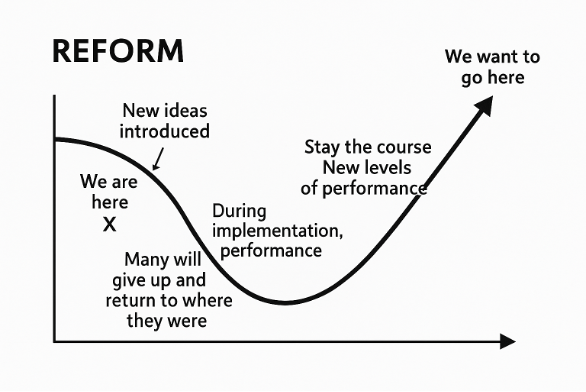By Dean Newlund.
Working for a company with a bold social or health mission feels like stepping into a sun-drenched room. People show up eager, hopeful, and ready to pour their whole selves into the cause. That energy is the blessing. It can also become the curse when day-to-day reality — budgets, deadlines, clashing styles — fails to live up to the lofty promise. Below is a frank look at both sides and a practical path forward for CEOs, team leaders, and HR pros who want the light without the burn.
The Blessing
There’s something magnetic about a workplace built on purpose. Many organizations today don’t just hire people to do the mission — they attract people who want to live it. Employees come in thinking, “I finally get to work somewhere that aligns with who I am.” The culture promises lifestyle balance, deep intentionality, and meaningful work — a kind of workplace utopia. The vision is so compelling that people often hope they’ll experience the same transformation the company seeks to bring to its customers. Personal well-being and professional life begin to blur in the best way. For many, that blend is the dream.
The real-world benefits of working at a purpose-driven company often look like this:
- Magnetic meaning – A clear purpose draws talent that could earn more elsewhere but chooses you because the work matters.
- Built-in engagement – People willingly blur the line between “job” and “life” if the mission resonates.
- Reputation lift – Customers, partners, and investors increasingly reward firms that tackle real problems.
The Curse
But then reality enters the room. Despite the purpose, there’s still conflict, silence, missed communication, and personality clashes — the same human challenges that exist everywhere else. Only now, they’re harder to swallow. When expectations are sky-high, the disappointment cuts deeper. Employees feel let down not just by their coworkers, but by the very vision they came for. The heartbreak is more personal. At traditional companies, culture is often separate from business goals. However, when financial pressures dominate or leadership styles skew too heavily toward metrics and away from meaning, it can feel like a betrayal — even if the intentions are good. During periods of rapid growth, decision fatigue, and emotional triggers, even the most well-meaning team can find itself spinning out of control.
People want to do their best. However, the stress makes it harder, and few know how to maintain the culture while running at full speed.
What makes it harder than it needs to be:
- Sky-high expectations – Employees expect every meeting, policy, and hallway chat to reflect the mission. When it doesn’t, disappointment feels personal.
- Purpose vs. profits whiplash – Finance-driven decisions can sound like a betrayal of the cause, even when they’re essential for survival.
- Underdeveloped conflict muscles – Teams avoid hard conversations to “keep the vibe positive,” only to watch trust erode in silence.
The Solution
So, how do you lead a company where purpose doesn’t become a liability? You build systems that honor both the human and the operational sides of the business. That means codifying the culture so it isn’t just spoken—it’s practiced. It means giving people regular time to reflect on how they’re living those values, especially when the pace gets intense. And it means being just as serious about measuring culture as you are about margins. Perhaps most importantly, it requires leaders who understand that meaningful change takes time—and who are willing to stay the course.
Behavior change often brings with it a frustrating paradox: performance and morale may temporarily dip just as new agreements, practices, or principles are introduced. People want results right away—and when they don’t see them, they assume something’s wrong. But this is normal. It’s called the Implementation Dip, and it’s a natural part of shifting from old ways of working to new ones. Those who succeed recognize this dip for what it is: not a failure, but a sign that transformation is underway.

Four practical practices that help purpose-driven organizations align their ideals with reality:
A living set of guiding principles
- Create 5-7 agreements that spell out how you behave when nobody’s looking.
- Post them, refer to them, revise them annually.
Why it Works – Principles move culture from “vibe” to visible standards. They also depersonalize feedback: you’re holding each other to the agreement, not to moods.
Cadenced culture time
- Block at least one hour a month for the team to audit how well they’re walking the principles.
- Start with quick, trust-building exercises: end with one concrete pledge for the coming month.
Why it Works – Culture is a muscle, not a memo. Regular reps keep it strong, even during growth spurts.
Twin scorecards
-
Track 3–5 business metrics (revenue, margin, cost to serve) and 3–5 culture metrics (engagement survey item tied to a principle, voluntary turnover of high performers, cross-team collaboration index).
-
Review both in the same deck, same meeting.
Why it Works – Seeing numbers for purpose and profit side by side signals they carry equal weight. Over time, correlations emerge that prove culture drives the bottom line.
A patience mindset
-
Leaders narrate progress like gardeners, not sprinters: “We planted X last quarter; here’s the early shoot we see.”
-
Celebrate micro-wins publicly and often.
Why it Works – Purpose work rarely follows a straight line. Naming the long game keeps anxiety in check and reduces the urge to chase every shiny tactic.
When a purpose-centered organization backs its vision with clear agreements, protected time to nurture them, and hard metrics for both heart and wallet, something quiet but powerful happens: people start walking their talk. And in those companies, the balance sheet and the culture map eventually tell the same success story. Culture and business outcomes stop being separate conversations — they become one.

